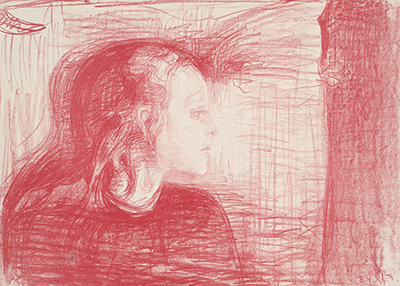Sickness rears its ugly head in much of Munch's career, such was his focus on raw emotion, often negative. He lived during a period when several diseases would sweep through society, meaning the appreciation of good health had never been so strong.
The artwork that we find here, titled Sick Child, was the first of several different drawings based on the same theme. He drew on emotions of his own and also others in order to drive his work, with his oeuvre generally being labelled with the term Expressionism, which is certainly the more appropriate movement for him. He was not only a painter, though most only know him as that because of the fame of his series of The Scream paintings. Munch actually was able to work to a high level as a draughtsman and also in lithography as well. The prints produced from his lithographs have also enabled others to learn about his career during his own lifetime, where they would have been completely unable to purchase his oil paintings. In recent years there has been a more comprehensive understanding of his career oeuvre delivered by academics, who have provided a better focus on all of the mediums in which he worked, rather than just focusing on his well known oil works.
Edvard Munch's life was full of tragedy and it was the death of his eldest sister, Johanne Sophie, whilst she was still a teenager, that left perhaps the biggest mark on his character. It would inspire a large body of work in different mediums as he perhaps attempted to rid himself of the grief that took over his mind for a period. Munch would clearly not be the first artist to gain artistic inspiration from pain and grief, but he was rare in it driving so much of his career and ultimately setting his expressionist style. He produced a famous artwork titled The Sick Child in 1885–86 but this drawing would arrive later, probably in 1896 when he created many portraits of his late sister in lithograph formats. It was a personal moment for him to do this, and that perhaps explains why so many elements of this series are considered amongst the best work that he produced. Without pain and tragedy within his life, Munch would have been a happier person but probably not as good an artist.
This interpretation of his sister, from all that the artist produced, is beautiful and depicts his dying sibling in the best way possible. She looks to her left whilst lying in bed. He uses crosshatched strokes of pencil to put this piece together, adding extra intensity to the hair and torso of his sister. Sadly she would die at just fifteen years of age, from tuberculosis in 1877. The sight of a child being struck down with illness is an emotive image that most would find hard to deal with, particularly once they had processed the back story around this drawing. Emotion would drive his career, and it seems that the stronger the emotions, then the better the paintings, drawings or lithographs that he produced. The losses in his family that he experienced as a child would never really leave him, and this grief stayed within his mind throughout the rest of his life.




